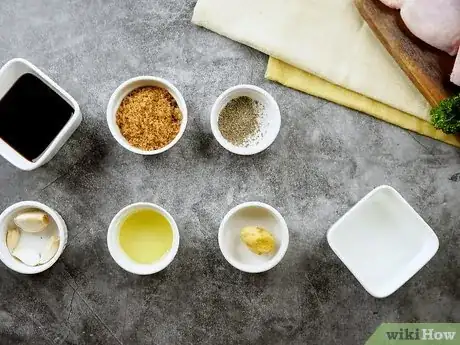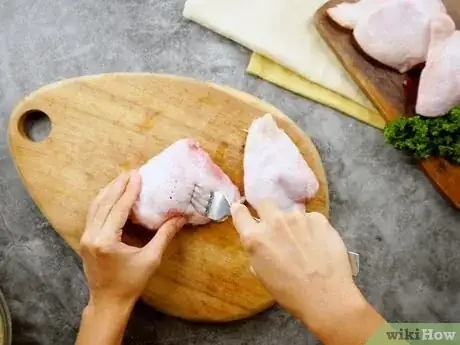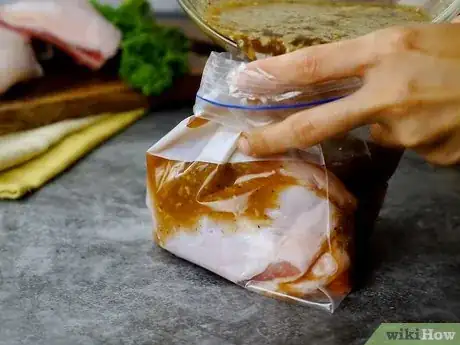This article was co-authored by wikiHow staff writer, Jessica Gibson. Jessica Gibson is a Writer and Editor who's been with wikiHow since 2014. After completing a year of art studies at the Emily Carr University in Vancouver, she graduated from Columbia College with a BA in History. Jessica also completed an MA in History from The University of Oregon in 2013.
There are 15 references cited in this article, which can be found at the bottom of the page.
The wikiHow Culinary Team also followed the article's instructions and verified that they work.
This article has been viewed 1,040,411 times.
Learn more...
If you love tender, juicy chicken that's packed with flavor, you need a good marinade! It's easy to whip up your own marinade using seasoning, oil, vinegar, or another acidic ingredient, but if you want some inspiration, we've got a few delicious recipes to get you started. Then, we'll walk you through the process of marinating the chicken so it absorbs the maximum amount of flavor before you cook it.
Things You Should Know
- Include bold ingredients in your marinade for maximum flavor—think lemon juice, soy sauce, brown sugar, or chipotle chiles in adobo.
- Coat chicken pieces or a whole bird in the marinade and refrigerate it for up to 24 hours so it absorbs the flavor of your marinade.
- Cook your marinated chicken using high heat to get great caramelized flavor. Toss the chicken on the grill, sauté it, or broil the chicken under high heat.
Ingredients
Lemon-Dijon Marinade[1]
- 1⁄2 cup (120 ml) of lemon juice
- 2 tablespoons (30 ml) of Dijon mustard
- 1 teaspoon (5 g) of salt
- A few grinds of freshly cracked pepper
- 1 cup (240 ml) of olive oil
Makes enough marinade for 1 pound (450 g) of chicken
Italian Marinade[2]
- 1⁄4 cup (59 ml) of olive oil
- 1⁄4 cup (59 ml) of red wine or balsamic vinegar
- 1⁄4 cup (59 ml) of lemon juice
- 1/2 teaspoon (2.5 g) of sugar
- 1/2 teaspoon (2.5 g) of salt
- 1/2 teaspoon (0.5 g) of dried thyme or oregano
- 1/2 teaspoon (0.5 g) of ground pepper or garlic powder
Makes enough marinade for 1 pound (450 g) of chicken
Asian Marinade[3]
- 1/4 cup (50 g) of packed brown sugar or molasses
- 1⁄2 cup (120 ml) of soy sauce
- 1⁄2 cup (120 ml) of water
- 1 teaspoon (4.9 ml) of olive oil, canola oil, or toasted sesame oil
- 1/2 teaspoon (0.5 g) of ground ginger or 3 tablespoons (18 g) of minced ginger
- 1 tablespoon (8.5 g) of minced garlic
- 1 teaspoon (2 g) of ground black pepper
Makes enough marinade for 1 pound (450 g) of chicken
Spicy Chipotle Marinade[4]
- 1/4 cup (60 g) of canned chipotle chiles in adobo, pureed
- 3 tablespoons (44 ml) of olive oil
- 2 garlic cloves, minced
- 1/2 of an onion, minced
- 1 tablespoon (7 g) of paprika
- 1 teaspoon (2 g) of ground cumin
- 1 teaspoon (2 g) of chili powder
- 1 teaspoon (5 g) of salt
Makes enough marinade for 3 pounds (1,400 g) of chicken
Steps
Making the Marinade
-
1Blend all of your marinade ingredients to get a thick liquid. It's hard for the flavor of chunky ingredients to penetrate meat, so it's important to blend them into a liquid marinade. If you don't have a blender, put all of the ingredients for your marinade into a food processor and combine them until they're smooth.[5]
- If your marinade recipe only calls for liquid ingredients and dry seasonings, feel free to skip the blender. Put all of the ingredients into a jar with a tight-fitting lid and shake until the marinade is combined.
-
2Customize your marinade if you want to adjust the flavors. The beauty of marinades is that you can substitute many ingredients as long as they serve the same purpose. For instance, if you don't want to use lemon juice, choose another acidic ingredient like vinegar or lime juice. Here are some categories of marinade ingredients that are easy to swap for one another:[6]
- Acidic ingredients: citrus juice of any kind (lemon, lime, grapefruit, orange), vinegar (white wine, red wine, apple cider, balsamic)
- Oils: olive oil, grapeseed oil, toasted sesame oil, avocado oil
- Sweeteners: brown sugar, molasses, maple syrup, honey, jam, ketchup, soda
- Seasonings: herb mixes, miso paste, Worcestershire sauce, garlic, ginger, shallots
Advertisement -
3Use the marinade immediately or store it in the fridge for up to 1 week. If you want to get a little prep work out of the way but you're not ready to marinate the chicken, you can make the marinade up to 1 week in advance.[7]
- If you want to baste the meat with marinade as it cooks, set aside a small bowl to use during cooking.
- For long-term storage, put the marinade into a freezer-safe container and freeze it for up to 3 months. Don't forget to label it or you may not remember what you're looking at!
Marinating the Chicken
-
1Poke the chicken with a fork so it absorbs the marinade. To help the marinade penetrate deeper into the meat, take a fork and poke the surface of the meat. The same marinades taste great with chicken breasts, thighs, legs, wings, or an entire bird. If your chicken still has the skin, there's no need to peel it.[8]
- If you're using chicken pieces, decide if you want to use bone-in pieces or boneless pieces—keep in mind that boneless pieces cook faster than bone-in or whole chicken.
-
2Place the raw chicken and marinade in a sealable bag. You can also use a food storage container that's large enough to hold all of your chicken. Put the chicken and marinade into your bag or container and turn the chicken until it's coated in the marinade. Then, seal the bag or cover the container.[9]
- Don't marinate chicken in a metal container or the metal will react with the acidic ingredients and create unpleasant flavors. Instead, stick with a ceramic or glass container.
-
3Marinate the chicken in the fridge for up to 24 hours. The longer the chicken marinates, the more flavor it will absorb. However, if you marinate the meat for more than 1 day, the acidic ingredients will break down the meat proteins which can make the chicken texture too soft or mushy.[10]
- If you're short on time, don't worry! Even 1 hour of marinating will give the chicken flavor.
- If you have a lot of acidic ingredients in the marinade or you're marinating boneless-skinless or thin pieces of chicken, go with a shorter marinating time.
- Always marinate chicken in the refrigerator instead of setting it out on the counter where bacteria can grow.[11]
-
4Remove the chicken from the marinade and pat it dry before you cook it. Prepare your heat source—turn on the oven or broiler, or heat a grill for instance. Then, take the chicken out of the marinade and set it on a platter. Use paper towels to pat the chicken dry. This also prevents excess marinade from burning.[12]
- If you want to use the leftover marinade in your bag, pour it into a saucepan and bring it to a boil.[13] Boil the marinade for a full minute to kill bacteria. Then, you can serve the sauce with the cooked chicken.
Cooking Marinated Chicken
-
1Bake the chicken in the oven for a hands-off meal. If you thought making the marinade was simple, you'll be impressed at how easy it is to cook the marinated chicken. Preheat the oven to 400 °F (204 °C), put the whole chicken into a baking dish, and roast it until it reaches 165 °F (74 °C) with an instant-read meat thermometer—this takes around 1 hour for a whole chicken.[14]
- If you're baking chicken parts, plan on cooking them for about 40 minutes per 1 pound (450 g).
- For extra flavor, pour the marinade over the chicken in the dish before you bake it.
-
2Cook it on the grill to give the chicken a smoky flavor. Preheat a gas grill or light a charcoal grill to create a 2-zone fire. Then, place the marinated chicken pieces on the cooler side of the grill. Cover the grill and cook the chicken, turning the pieces occasionally, and taking them off once they reach 165 °F (74 °C) with an instant-read meat thermometer.[15]
- If you'd like to baste the meat during the last few minutes, use reserved marinade that you didn't marinate the chicken. Don't baste the meat with marinade that raw chicken came into contact with.
- If you're cooking boneless chicken pieces, they'll cook faster, so start checking them after 8 to 12 minutes. Bone-in pieces of chicken take around 30 minutes to cook.
-
3Broil chicken pieces to get lots of caramelized flavor. Position the oven rack so it's 6 inches (15 cm) below the broiler element and arrange your marinated chicken pieces on a baking sheet. Broil the chicken pieces for 10 to 15 minutes before you turn them and finish cooking them—the meat should reach 165 °F (74 °C) with an instant-read meat thermometer.[16]
- Boneless chicken pieces take about 15 to 20 minutes total to broil, while bone-in pieces need longer—around 25 to 35 minutes total.
-
4Sauté boneless chicken pieces on the stovetop. For a weeknight dinner that comes together in flash, heat a few spoonfuls of oil in a skillet over medium-high heat. Lay the boneless chicken breasts in the skillet and cook them for 5 to 7 minutes. Then, use tongs to flip them over and cook them for another 7 minutes or until they reach 165 °F (74 °C) with an instant-read meat thermometer.[17]
- If you like crispy chicken, coat it in seasoned flour breading before you cook it in the skillet.
Community Q&A
-
QuestionCan I just leave my chicken and marinade in a pot and put it in the fridge for a day?
 Community AnswerYes, as mentioned above, you can leave it longer than 4 hours. Marinating the chicken for more than 3 days is a bit overkill, the flavors won't be stronger past that point - all the sauce would be spread evenly inside the chicken.
Community AnswerYes, as mentioned above, you can leave it longer than 4 hours. Marinating the chicken for more than 3 days is a bit overkill, the flavors won't be stronger past that point - all the sauce would be spread evenly inside the chicken. -
QuestionIs it safe for me to bake the marinated chicken, and then once done, pour the left over marinade over the chicken?
 Community AnswerNo - the marinade has juices from the raw chicken in it, so you would essentially be eating raw chicken.
Community AnswerNo - the marinade has juices from the raw chicken in it, so you would essentially be eating raw chicken. -
QuestionWhy would I want to pour the excess marinade over the chicken if it was sitting in raw chicken?
 Community AnswerTo give the chicken extra flavor and juiciness. The chicken you're pouring it over is raw, too. It's all going to be baked, so that's a non-issue.
Community AnswerTo give the chicken extra flavor and juiciness. The chicken you're pouring it over is raw, too. It's all going to be baked, so that's a non-issue.
Things You'll Need
- Measuring cups and spoons
- Blender
- Sealable plastic bag or food storage container
- Instant-read meat thermometer
References
- ↑ https://www.foodnetwork.com/recipes/ina-garten/chicken-marinade-recipe-1918566
- ↑ https://www.food.com/recipe/oil-and-vinegar-marinade-180021
- ↑ https://www.justapinch.com/recipes/main-course/asian/asian-sauces-2.html
- ↑ https://www.epicurious.com/recipes/food/views/spicy-chipotle-grilled-chicken-235349
- ↑ https://www.allrecipes.com/article/how-to-marinate-chicken/
- ↑ https://www.cooksmarts.com/articles/marinating-times-tips-and-easy-marinade-recipes/
- ↑ https://realsimplegood.com/5-easy-homemade-marinade-recipes/
- ↑ https://www.cooksillustrated.com/how_tos/5564-marinating-tips-for-success
- ↑ https://www.allrecipes.com/article/how-to-marinate-chicken/
- ↑ https://www.southernliving.com/how-to/cook/how-long-to-marinate-chicken
- ↑ https://digitalcommons.usu.edu/cgi/viewcontent.cgi?article=1307&context=extension_curall
- ↑ https://www.cooksillustrated.com/how_tos/5564-marinating-tips-for-success
- ↑ https://www.fda.gov/media/154050/download
- ↑ https://www.foodsafety.gov/keep/charts/mintemp.html
- ↑ https://www.thekitchn.com/10-tips-for-perfect-grilled-chicken-220947
- ↑ https://www.bhg.com/recipes/how-to/handling-meat/how-to-broil-chicken/
- ↑ https://www.thekitchn.com/how-to-cook-golden-juicy-chicken-breast-on-the-stove-248171
- ↑ https://www.fda.gov/media/154050/download
- ↑ https://www.fda.gov/media/154050/download
About This Article
To marinate chicken, use a store-bought marinade or create one from scratch using your favorite recipe. If your marinade includes chunky ingredients, like pieces of garlic or ginger, combine the ingredients in a blender until you have a thick, uniform liquid. Poke the chicken all over with a fork to help the marinade absorb into the meat. Put the chicken pieces in a resealable bag along with the marinade and turn the bag over a few times to thoroughly coat the chicken. Refrigerate the chicken for up to 24 hours. Remove it from the container with the marinade and pat it dry with paper towels before cooking it. If you want to learn different ways you can cook the chicken after it's been marinaded, keep reading the article!





























































